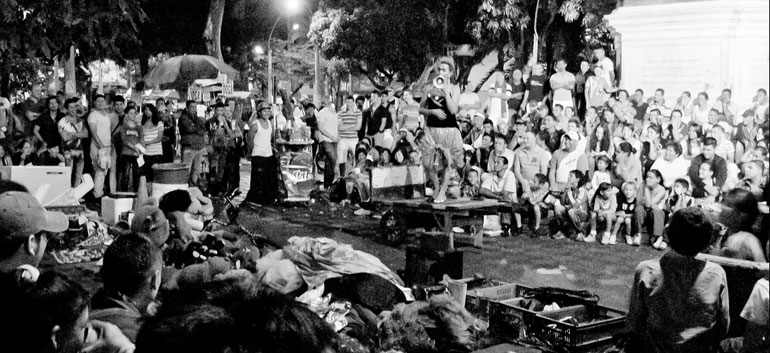Downtown Medellin, my home, is one of the most colorful places I have known in my life. It’s not the prettiest or safest place on earth, but it’s very interesting, vibrant and exotic.
I must admit it’s one of the most sordid places I know. Since moving here in 2008, I have grown used to seeing dead people, 12-year-old children selling their bodies, people with limbs missing, me being attacked with knives, junkies shooting up in the middle of the street, transvestites with ass-implants three times the size of their head, and people smoking pot — lots of people smoking pot.
Because the 10th district is the city center, particularly the Candelaria neighborhood where I live, this sordidness is mostly absorbed or integrated into normal life during the day, as people from all parts of town come to my neighborhood to work or shop, and flood the city with colors and sounds.
The Candelaria is the old banking district. Consequently you see plenty of people in office outfits. Adding to that, people from the poorer neighborhoods up in the hills descend onto downtown to work in one of the thousands of shops, or to sell fruit or cigarettes or shoelaces on the street. This temporary integration of social classes is another thing that makes downtown Medellin so fascinating. One can just carelessly sit on any street corner and watch a thousand movies at once.
Another particular form of integration takes place among those living downtown. As a resident, you actually get to personally know the militia members, security guards, thieves and beggars. Within the neighborhood we call each other “neighbor” regardless whether a person has a roof over his head or not. This provides a social fabric that is not just very pleasant, but also important for personal safety when the night comes.
Reasons to love downtown
Reasons to hate downtown
|
At night, the 10th district — which I so proudly call my home, undergoes a fascinating but partly eerie transformation.
Between 6PM and 8PM all commuters and cops go home and “El Centro” becomes one of the most desolate districts of the city.
Around that time, on the lower side of town — west of Oriental Avenue, strip clubs, gambling halls and motels start receiving significant numbers of visitors, while underage prostitutes take to the streets to score clients and drugs.
By 9PM, downtown has become one of the most dangerous areas in the city for these very obvious reasons.
However, at the same time, a very particular and highly bohemian nightlife comes out of the closet east of Oriental.
Over the past few years, an increasing number of bars, boutiques and restaurants have opened doors particularly in safer areas like the Bombona towers, around Parque Periodista and on Cordoba street where the local government is successfully trying to promote culture.
Subsequently, cute little theaters have been popping up like they were artsy mushrooms, creating a cultural vibe unique to El Centro.
The center’s traditional residents are mostly elderly (and sometimes very quirky) people, but because of the increase in cultural offerings, access to public transport and public education and this downtown subculture, the area appears to be changing rapidly as more young people are drawn downtown, further spurring the development of bars, restaurants and clubs.
And it’s exactly this optimistic development and visible growth, and the ever-changing tension between good and evil, that makes me want to live here. It’s why I so passionately love downtown Medellin, even though it doesn’t always love me back.


